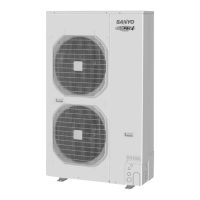2
2-32
2-32-3. Checking indoor unit addresses
Use the remote controller to check the addresses of the
indoor units. Press and hold the button and
button for 4 seconds or longer (simple settings mode,
“ALL” appears on the remote controller).
Then press the button and select the indoor
address.
(For the system addresses of the No. 1 outdoor unit,
each time the button is pressed, the address changes
as follows: 1-1, 1-2, ...)
The indoor unit fan operates only at the selected indoor
unit. Confirm the indoor unit address. (For the system
addresses of the No. 2 outdoor unit, the displayed
addresses are 2-1, 2-2, ...)
Press the button again to return to the normal remote
controller mode.
Fig. 2-32
2-32-4. Indicating (marking) the indoor and outdoor
unit combination number
Indicate (mark) the number after automatic address
setting is completed.
(1) So that the combination of each indoor unit can be
easily checked when multiple units are installed,
ensure that the indoor and outdoor unit numbers
correspond to the system address number on the
outdoor unit control PCB, and use a magic marker
or similar means which cannot be easily removed to
indicate the numbers in an easily visible location on
the indoor units (near the indoor unit nameplates).
Example: (Outdoor) 1 – (Indoor) 1, 2...
(Outdoor) 2 – (Indoor) 1, 2...
(2) These numbers will be needed for maintenance.
Be sure to indicate them.
Installing the batteries
(1) Press on both sides of the remote controller cover
and slide it downward to remove it.
(2) Insert 2 AAA alkaline batteries. (Pay attention to the
+ and – directions.)
(3) Gently insert one end of an unfolded paper clip (or
a similar object that can fit) into the Reset hole and
press the reset button inside the hole and then put
the cover back on.
To remove the remote controller, pull it toward you.
Fig. 2-34
Precautions for remote controller installation
Before mounting the remote controller on the wall,
place the unit at the mounting position, then turn on
any fluorescent lamps, press the ON/OFF button,
and check that the air conditioner operates correctly.
When using the remote controller to detect the room
temperature, observe the following precautions
during installation:
• Avoid locations where the remote controller will be
exposed to the direct path of air blown from the air
conditioner.
• Avoid locations where the remote controller will be
exposed to direct sunlight.
• Avoid locations where the remote controller will be
exposed to direct heat sources.
2-33. Caution for Pump Down
Pump down means refrigerant gas in the system is
returned to the outdoor unit. Pump down is used when
the unit is to be moved, or before servicing the
refrigerant circuit.
CAUTION
This outdoor unit cannot collect more than the
rated refrigerant amount as shown by the
nameplate on the back.
Reset hole
Cover
Installing the Remote Controller
If the remote controller is to be installed onto a wall
or other surface for use, first place the remote
controller in the location where it will be installed and
press (ON / OFF).
Confirm that the “signal-received” sound occurs at
the indoor unit and that the A/C begins operating.
1
2
Fig. 2-33
Fasten the remote control
mount with screws.
Remote control mount
Put in
Fitting the remote control
in the mount.
Press
If the amount of refrigerant is more than that
recommended, do not conduct a pump down.
In this case use another refrigerant collecting
system.
SM830161Book.indb32SM830161Book.indb32 2008/06/039:09:052008/06/039:09:05

